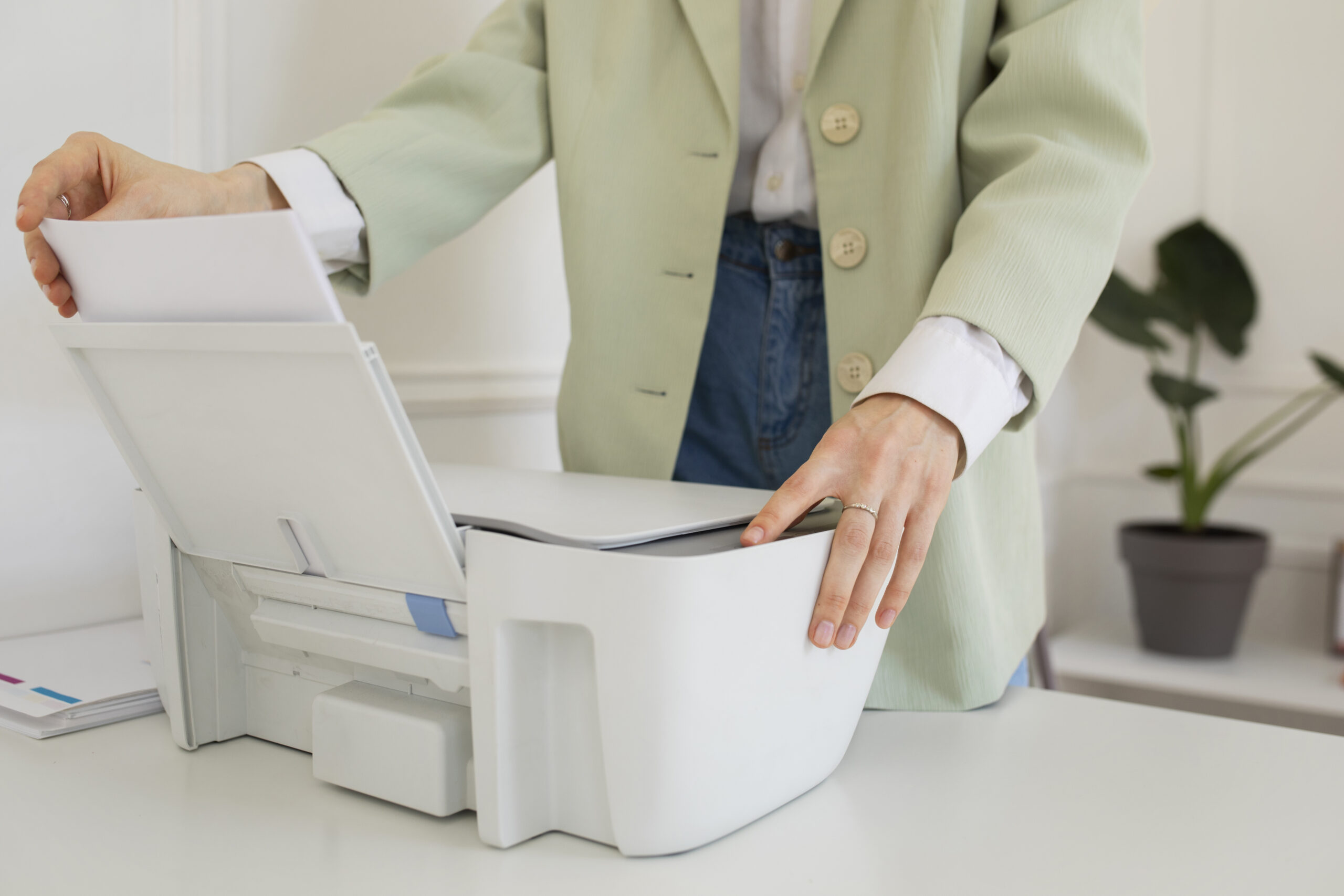Scanner Not Detected? Step-by-Step Fix for Windows & macOS

What “scanner not detected” really means
“Not detected” is a generic front-end message. The operating system (or scanning app) looked for a device that can provide images and did not receive a valid response. That failure can happen for several reasons: the device is asleep, disconnected, blocked by privacy permissions or a firewall, is using drivers the OS no longer trusts, or has landed on a different IP address than the one your computer remembers. In other words, the scanner may be fine—your computer has simply lost the path to it.
To fix this quickly we’ll stabilise the simple links first (power, cables, Wi-Fi), then re-open the OS pathways that scanners rely on (permissions, services and drivers). We’ll work brand-neutral, so whether you use HP, Canon, Epson, Brother, Ricoh, or a small portable wand scanner, the steps stay the same.
Fast checks before the deep fixes
- Power & sleep: Wake the scanner by pressing the power or Start button. Many units disable network modules in deep sleep.
- Cables: For USB, reseat both ends firmly; avoid loose front-panel PC ports. For Ethernet, ensure the link light is on.
- Wi-Fi band: Keep both scanner and computer on the same SSID. Prefer 2.4 GHz for range if the device does not support 5 GHz well.
- Airplane/Focus/Firewall modes: Make sure the OS is online and not blocking local devices.
- Try the other app: On Windows use Scan (Microsoft’s modern app). On macOS try Image Capture or Preview > Import from Scanner.
- One cable at a time: If your all-in-one supports both USB and Wi-Fi, prefer one during setup (USB or Wi-Fi), not both.
Method 1 — Power cycle & basic resets (both systems)
We start simple to clear stale states in the scanner, driver, and network stack.
- Turn the scanner off and unplug it for 30–60 seconds. This flushes cached network modules and resets USB negotiation.
- Restart your computer. It clears device caches, stuck services, and pending driver updates.
- Power on the scanner and wait until it is fully ready (no flashing Wi-Fi or error lights).
- Reconnect the USB cable (use a direct port on the computer) or confirm the scanner shows as connected to your Wi-Fi.
- Try a test scan using a built-in app:
- Windows: Open Scan (type “Scan” in Start).
- macOS: Open Image Capture from Applications.
Method 2 — Windows: Allow access, connections & Scan app
Windows can hide scanners behind privacy toggles, missing features, or driver mismatches. Walk through these in order:
2.1 Confirm Windows sees any imaging device
- Press Win + X → Device Manager → expand Imaging devices / Cameras. If your model appears with a warning icon, right-click → Uninstall device → tick “Delete the driver software” → Uninstall. Restart and reconnect.
- If nothing shows, test a different USB port (prefer rear I/O on desktops) or another cable. For laptops, avoid bus-powered hubs during setup.
2.2 Give apps permission to use scanners/cameras
- Settings → Privacy & security → Camera (and Documents / Pictures library access). Enable Allow apps to access your camera and ensure Scan is allowed.
2.3 Install Windows’ optional features for older drivers
- Settings → Apps → Optional features → Add an optional feature. If your legacy device needs it, add Windows Fax and Scan or Microsoft .NET Framework 3.5 components sometimes required by vendor tools.
2.4 Try with Microsoft’s Scan app
- Open Scan. If your device appears, select it → choose File type and Resolution → Scan. If it does not appear, click Change scanner → Find scanners. If “No scanners were found”, continue to Method 4.
Method 3 — macOS: Privacy, drivers & Image Capture
macOS includes class drivers for many scanners and often just needs permission or a re-add in System Settings.
3.1 Check permissions
- Apple menu → System Settings → Privacy & Security → Files and Folders. Ensure your scan apps (Image Capture, Preview, vendor utility) have access to Documents and Desktop.
- In Full Disk Access, temporarily allow your vendor app if it requests access to write scans to protected folders.
3.2 Test with Apple’s built-ins
- Open Image Capture (Applications). Your scanner should appear under Devices (USB) or Shared (network via Bonjour/AirPrint). If not, proceed to Method 5.
- Alternatively, open Preview → File → Import from Scanner.
3.3 If you previously used vendor software
Out-of-date legacy drivers may conflict with updated macOS frameworks. We’ll cleanly remove them in Method 5 and re-add the scanner using AirPrint/Bonjour where possible.
Method 4 — Repair or reinstall drivers (Windows)
This targets stale or partial drivers that prevent the Scan app from detecting the device.
4.1 Remove old entries
- Settings → Bluetooth & devices → Printers & scanners.
- Select your device → Remove. If you see multiple entries (USB, network, WSD), remove all.
4.2 Purge the driver package
- Press Win + R → type
printui /s /t2→ OK. In the Print Server Properties window, remove your scanner/printer drivers (especially “WSD Scan Device” variants) and delete driver package if prompted.
4.3 Reinstall minimal support
- Reconnect via USB first for reliability. Let Windows Update fetch a driver. If the device is only a scanner, Windows may list it under Cameras or Imaging devices.
- If Windows Update doesn’t find one, download your vendor’s basic driver (avoid heavy suites at first). Install, reboot, and test in the Scan app.
Method 5 — Remove & re-add the scanner (macOS)
macOS prefers clean, modern drivers via AirPrint/Bonjour. We’ll reset the print/scan system and re-add the device.
5.1 Remove the device
- Apple menu → System Settings → Printers & Scanners.
- Select the scanner/printer → Remove Printer.
5.2 (Optional) Reset printing system
- Right-click (or Ctrl-click) in the devices list → Reset printing system…. This removes all printers/scanners and clears queues and drivers.
5.3 Re-add the device the modern way
- Click Add Printer, Scanner, or Fax.
- Select your device. Prefer the AirPrint or Bonjour driver if available. For pure scanners, select the device under Default or IP (if you know its address).
- Test in Image Capture. If detection is still unreliable, see Method 6 to stabilise the network path.

Method 6 — Network scanners: IP, protocols & firewall
When a network scanner vanishes, it’s usually an IP address change or a discovery problem (Bonjour/WSD). Make the address stable and ensure discovery and scan ports are allowed.
6.1 Give the scanner a stable address
- Open your router’s admin page → reserve a DHCP address (a.k.a. DHCP reservation) for the scanner’s MAC address. Alternatively set a Static IP on the scanner’s panel within the same subnet.
- Note the IP (e.g.,
192.168.1.50).
6.2 Add the scanner by IP
- Windows: Settings → Bluetooth & devices → Printers & scanners → Add device → Add manually → Add a printer using a TCP/IP address → enter IP. If the device provides a scan service, Windows will expose it to the Scan app.
- macOS: System Settings → Printers & Scanners → Add → IP → enter IP. Choose AirPrint if offered.
6.3 Allow discovery and scan traffic
- Bonjour/mDNS: UDP 5353 must not be blocked on your network (used by macOS and many vendors).
- WSD: Windows discovery for some all-in-ones; if flaky, add by IP instead.
- Vendor web UI: Open the scanner’s IP in a browser to confirm status and run test scans if supported.
Method 7 — USB scanners: ports, hubs & cables
USB issues masquerade as “not detected.” Stabilise the link and renegotiate cleanly.
- Use a short, known-good cable (prefer 1–1.8 m). Replace any frayed or overly long cable.
- Try different ports—rear motherboard ports on desktops are most reliable. Avoid daisy-chained hubs for setup.
- USB 2.0 vs 3.0: Some older scanners behave better on USB 2.0 ports. If your 3.0 port has issues, test a 2.0 one (often black insert).
- Remove conflicts: Unplug other heavy USB devices during testing (capture cards, external drives).
- Reinstall after cable change: Windows may create a new device instance per port; remove old entries (see Method 4) then plug in once.
Method 8 — Built-in troubleshooters (Windows)
Windows includes tools that repair services and reset device stacks.
8.1 Printer/Scanner troubleshooter
- Settings → System → Troubleshoot → Other troubleshooters → run the Printer troubleshooter (it also targets scan endpoints on many all-in-ones).
8.2 Restart essential services
- Press Win + R → type
services.msc. Restart Function Discovery Provider Host, Function Discovery Resource Publication, and Windows Image Acquisition (WIA). If WIA is disabled, set Startup type to Automatic.
8.3 Optional repair commands
If system files are damaged, repairs can help. Open an elevated Command Prompt and run:
sfc /scannow— verifies system files.DISM /Online /Cleanup-Image /RestoreHealth— repairs the component store.
Reboot, then test in the Scan app.
Method 9 — Vendor utilities (HP, Canon, Epson, Brother)
Once the OS pathways work, vendor tools unlock features like multi-page PDF, OCR, and auto-crop. Use them after the device is detected at least once in a built-in app.
- HP: HP Smart or HP Easy Start.
- Canon: IJ Scan Utility / Canon IJ Printer Assistant Tool.
- Epson: Epson Scan 2.
- Brother: iPrint&Scan.
Install the lightest package first (scan utility only), test, then add extras such as OCR modules if needed.
Method 10 — Advanced: services, logs & clean reinstall
Use these when normal reinstalls fail or detections are intermittent.
10.1 Windows: WIA and imaging pipeline
- Ensure Windows Image Acquisition (WIA) is running (see Method 8).
- Device Manager → View → Show hidden devices. Remove greyed-out scanner entries under Imaging devices.
- In Event Viewer (Win + X), check Applications and Services Logs > Microsoft > Windows > WIA for repeated errors. If persistent, do a clean reinstall (next step).
10.2 Clean reinstall (Windows)
- Disconnect the scanner.
- Remove devices and drivers (Method 4). Reboot.
- Install the basic driver, reconnect when prompted, then add any optional utilities.
10.3 macOS: Remove legacy plugins
- Check
/Library/Image Capture/Devices/and/Library/Image Capture/TWAIN Data Sources/for old vendor components. If you identify a legacy plug-in from an uninstalled app, move it to a backup folder and reboot. - Reset printing system and re-add with AirPrint (Method 5).
Apps that scan reliably (free, built-in & light)
| Platform | App | Why use it | Notes |
|---|---|---|---|
| Windows | Scan (Microsoft) | Modern UI, quick detection | Great for JPG/PNG; simple PDF |
| Windows | Windows Fax and Scan | Works with older drivers | Classic UI; reliable for legacy |
| macOS | Image Capture | Native; supports many brands | Fast to test connectivity |
| macOS | Preview > Import | Convenient for quick pages | Ideal to verify detection |
| Both | Vendor utilities | Duplex, OCR, multipage PDFs | Install after OS detection works |
Router-side stability tweaks for network scanners
Network scanners are happiest on a predictable LAN. Small tweaks remove randomness that breaks discovery.
- DHCP reservation: Lock the scanner’s IP so Windows/macOS always find it.
- Single SSID for 2.4/5 GHz: Some older devices struggle if band steering is aggressive. Consider a dedicated 2.4 GHz SSID for IoT/print gear.
- mDNS/Bonjour: Ensure your router isn’t blocking multicast. On business networks, allow mDNS across VLANs if clients and devices are separated.
- Channel quality: Pick a quiet 2.4 GHz channel (1, 6 or 11) to avoid intermittent drops during scans.

Troubleshooting matrix
| Symptom | Likely cause | Do this first | If still bad |
|---|---|---|---|
| Scanner shows once, then disappears | Dynamic IP; sleep | Reserve DHCP; disable deep sleep | Add by IP; update firmware |
| USB scanner never appears | Cable/port power | Short new cable; rear port | Remove drivers; reinstall minimal |
| App says “No scanners found” | Permissions blocked | Enable Camera/Files access | Try built-in app; reinstall |
| macOS sees printer, not scanner | Wrong driver | Re-add with AirPrint | Reset printing system; remove legacy plug-ins |
| Starts scan, then fails | Wi-Fi drop / firewall | Move closer; allow mDNS | Use Ethernet/USB; static IP |
| Windows Scan app empty list | WIA stopped | Restart WIA service | SFC/DISM; reinstall driver |
| Very slow over network | 2.4 GHz congestion | Switch channel/5 GHz | Use Ethernet during jobs |
Common error messages & what they mean
| Message (varies by app/vendor) | What it means | Quick response |
|---|---|---|
| No scanners were detected | OS can’t see a device endpoint | Method 1, then 2/3 |
| Cannot communicate with scanner | Driver mismatch or IP changed | Methods 4–6 |
| Scanner is in use | Another app holds the device | Close other apps; reboot |
| TWAIN/WIA error | Acquisition stack fault | Restart WIA; reinstall driver |
| AirPrint scanner not available | Bonjour discovery failed | Ensure mDNS; re-add by IP |
Prevent it happening again: a tiny routine
- Stabilise IPs: Reserve DHCP for every networked scanner.
- Keep software lean: Only install full suites after detection works in native apps.
- One path: Use either USB or Wi-Fi/Ethernet during setup to avoid duplicate entries.
- Test monthly: A quick scan prevents surprises before deadlines.
- Update firmware sensibly: Only when release notes mention reliability or security.
FAQs
Is a separate scan app necessary?
No. Use the built-in apps first (Windows Scan, Image Capture). If detection is stable there, vendor apps can add OCR and multi-page features later.
Why does my multifunction print fine but won’t scan?
Printing and scanning use different drivers and services. WIA/AirPrint Scan can fail while print still works. Re-add with AirPrint (macOS) or repair WIA (Windows) using Methods 4–6.
USB works, Wi-Fi doesn’t. Which should I keep?
If mobility isn’t essential, Ethernet or USB is the most stable. For Wi-Fi, reserve a DHCP address and keep the device within strong signal range.
Do I need TWAIN drivers on macOS?
Usually not. AirPrint/Bonjour supports scanning for many devices. Only install legacy TWAIN if a specific feature demands it and your macOS version allows.
Windows shows two entries for the same device. Is that a problem?
It can be. Remove duplicates (USB + WSD) and keep one path. Reinstall once on the chosen port or IP for reliability.
What resolution should I scan at?
Text: 200–300 dpi; receipts: 300 dpi greyscale; photos: 300–600 dpi. Higher DPI increases file size and scan time without visible gains for most documents.
How do I share a network scanner in a small office?
Give it a reserved IP, enable Bonjour/mDNS, and add it by IP on every computer. Avoid guest networks that block device-to-device traffic.
My scans stop at random pages. What now?
Wi-Fi drops or a sleep timer can interrupt. Use Ethernet/USB for large multi-page jobs and disable deep sleep during scanning.
Is it safe to reset the macOS printing system?
Yes, but it removes all printers/scanners. Note your IPs and re-add with AirPrint/Bonjour afterwards. It’s a clean way to clear old, conflicting drivers.
Do VPNs affect scanning?
Sometimes. VPNs can block local network discovery. Pause the VPN during scanning or allow local LAN access in the VPN settings.
